


#TRAILRUNNER MINI MANUAL#
Now as landmarks remember their connections to other landmarks, this manual correction is only required once. So what happens is that you are always compelled to insert intermediate transit locations until the course matches your intention. If you are not very accustomed to how routing without landmarks works, just realize that routing in TrailRunner mini uses the shortest path to reach one transit location to another. The second quick tutorial shows how that happens: No intermediate transit locations required. After this has happened (and as soon as you create a route that follows the same course of landmarks) TrailRunner mini will be able to directly connect the two landmarks - based on the memorized course. When you connect two landmarks (even by placing intermediate transit location pins) TrailRunner mini remembers the course you have chosen to reach a landmark outgoing from a previous landmark. (Expert users could have used the roundtrip setting in the left route planning pane to omit the last step) So it's basically a route from the starting landmark ➜ over a transit pin ➜ to the newly created signpost landmark ➜ over a second transit pin ➜ and back to the starting landmark. Please note that the route created used two intermediate transit location pins to direct the routing over the specific course of the demo. Then, during routing, the tutorial shows how a new landmark is being added and how the route returns to the point where you have started. The following quick tutorial shows how you start a new route from an existing landmark. Within this context a landmark becomes a waypoint.Īs the prior is pretty simple to understand, the latter requires some explanations. Add landmarks to easily jump to a location by selecting the landmark in the landmarks popover. Just a geographic bookmark (or point of interest ) you can set for yourself.Introduction: Landmarks in TrailRunner mini can be:


 0 kommentar(er)
0 kommentar(er)
